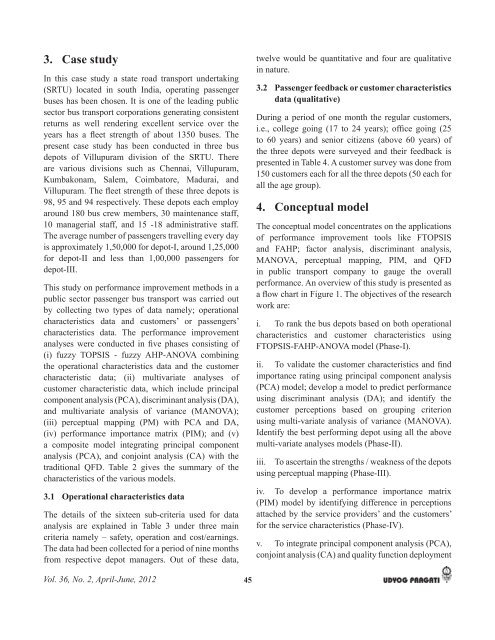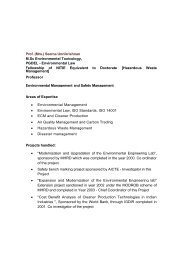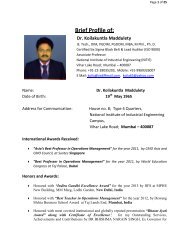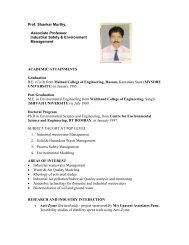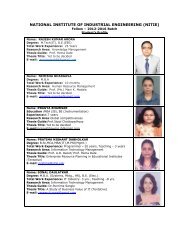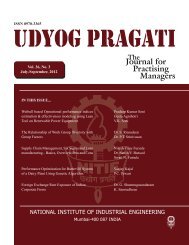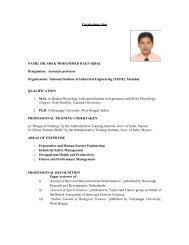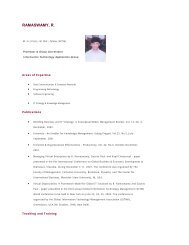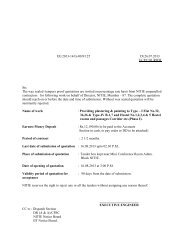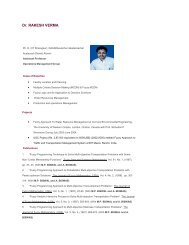Apr-Jun.12 - the Nitie
Apr-Jun.12 - the Nitie
Apr-Jun.12 - the Nitie
Create successful ePaper yourself
Turn your PDF publications into a flip-book with our unique Google optimized e-Paper software.
3. Case study<br />
In this case study a state road transport undertaking<br />
(SRTU) located in south India, operating passenger<br />
buses has been chosen. It is one of <strong>the</strong> leading public<br />
sector bus transport corporations generating consistent<br />
returns as well rendering excellent service over <strong>the</strong><br />
<br />
present case study has been conducted in three bus<br />
depots of Villupuram division of <strong>the</strong> SRTU. There<br />
are various divisions such as Chennai, Villupuram,<br />
Kumbakonam, Salem, Coimbatore, Madurai, and<br />
<br />
98, 95 and 94 respectively. These depots each employ<br />
around 180 bus crew members, 30 maintenance staff,<br />
10 managerial staff, and 15 -18 administrative staff.<br />
The average number of passengers travelling every day<br />
is approximately 1,50,000 for depot-I, around 1,25,000<br />
for depot-II and less than 1,00,000 passengers for<br />
depot-III.<br />
This study on performance improvement methods in a<br />
public sector passenger bus transport was carried out<br />
by collecting two types of data namely; operational<br />
characteristics data and customers’ or passengers’<br />
characteristics data. The performance improvement<br />
<br />
(i) fuzzy TOPSIS - fuzzy AHP-ANOVA combining<br />
<strong>the</strong> operational characteristics data and <strong>the</strong> customer<br />
characteristic data; (ii) multivariate analyses of<br />
customer characteristic data, which include principal<br />
component analysis (PCA), discriminant analysis (DA),<br />
and multivariate analysis of variance (MANOVA);<br />
(iii) perceptual mapping (PM) with PCA and DA,<br />
(iv) performance importance matrix (PIM); and (v)<br />
a composite model integrating principal component<br />
analysis (PCA), and conjoint analysis (CA) with <strong>the</strong><br />
traditional QFD. Table 2 gives <strong>the</strong> summary of <strong>the</strong><br />
characteristics of <strong>the</strong> various models.<br />
3.1 Operational characteristics data<br />
The details of <strong>the</strong> sixteen sub-criteria used for data<br />
analysis are explained in Table 3 under three main<br />
criteria namely – safety, operation and cost/earnings.<br />
The data had been collected for a period of nine months<br />
from respective depot managers. Out of <strong>the</strong>se data,<br />
twelve would be quantitative and four are qualitative<br />
in nature.<br />
3.2 Passenger feedback or customer characteristics<br />
data (qualitative)<br />
During a period of one month <strong>the</strong> regular customers,<br />
<br />
to 60 years) and senior citizens (above 60 years) of<br />
<strong>the</strong> three depots were surveyed and <strong>the</strong>ir feedback is<br />
presented in Table 4. A customer survey was done from<br />
150 customers each for all <strong>the</strong> three depots (50 each for<br />
all <strong>the</strong> age group).<br />
4. Conceptual model<br />
The conceptual model concentrates on <strong>the</strong> applications<br />
of performance improvement tools like FTOPSIS<br />
and FAHP; factor analysis, discriminant analysis,<br />
MANOVA, perceptual mapping, PIM, and QFD<br />
in public transport company to gauge <strong>the</strong> overall<br />
performance. An overview of this study is presented as<br />
<br />
work are:<br />
i. To rank <strong>the</strong> bus depots based on both operational<br />
characteristics and customer characteristics using<br />
FTOPSIS-FAHP-ANOVA model (Phase-I).<br />
<br />
importance rating using principal component analysis<br />
(PCA) model; develop a model to predict performance<br />
using discriminant analysis (DA); and identify <strong>the</strong><br />
customer perceptions based on grouping criterion<br />
using multi-variate analysis of variance (MANOVA).<br />
Identify <strong>the</strong> best performing depot using all <strong>the</strong> above<br />
multi-variate analyses models (Phase-II).<br />
iii. To ascertain <strong>the</strong> strengths / weakness of <strong>the</strong> depots<br />
using perceptual mapping (Phase-III).<br />
iv. To develop a performance importance matrix<br />
(PIM) model by identifying difference in perceptions<br />
attached by <strong>the</strong> service providers’ and <strong>the</strong> customers’<br />
for <strong>the</strong> service characteristics (Phase-IV).<br />
v. To integrate principal component analysis (PCA),<br />
conjoint analysis (CA) and quality function deployment<br />
Vol. 36, No. 2, <strong>Apr</strong>il-June, 2012<br />
45


